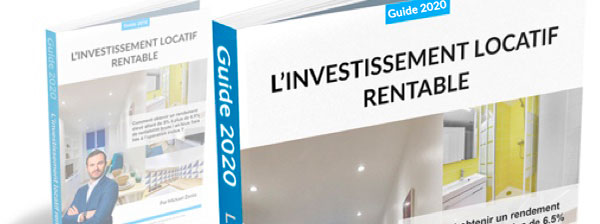Rental tension: correctly calculate rental demand and make the right choice
Rental property investment is one of the most profitable investment solutions if you go about it right. You will then have to ensure that you obtain an advantageous cash flow to benefit from at least self-financing. However, one question remains: "What would happen if your rental property cannot be rented?" It is clear that vacant accommodation can quickly become cumbersome. This is where rental tension comes in, one of the key indicators when selecting the location for your real estate investment. It particularly depends on rental demand in each city in France.
The specificities of rental tension
When making a rental property investment in a city, the main objective is to increase assets before generating additional income from rents. These gains will then be allocated to repaying credit and paying income tax. The ideal is to make an investment that creates a positive cash flow, favorable to self-financing. It will then be necessary to define whether the target market is under pressure or not, in addition to offering a good return and an affordable purchase price.
Real estate investors must limit rental risks (vacancy and non-payment) to guarantee an optimal return on each investment. It is therefore crucial that a rental property can quickly find a buyer, during its marketing, but also for its re-rental. Location is a decisive factor in attracting the tenant during their search for a residence. Rental tension is another. Comparing supply and demand in a predetermined area (Paris, Amiens, Angers, etc.) is the way to know whether or not it is possible to easily rent a property.
Concretely, rental tension is defined as the difference between rental demand and supply in each of the cities of France, and in each of their districts. It constitutes in fact a key element for making a purchasing decision at the level of the real estate market of these areas. A sector in rental tension (tense zone) shows that the demand for housing remains lower than the average rental offer. In this circumstance, your property will be able to quickly find a taker (students, young workers, families, etc.). Then, the rental vacancy cycles will be shorter.
Conversely, if the rental supply exceeds demand, you will have difficulty finding a tenant. Rental tension does not depend on real estate prices in cities or on the rents charged for housing of all types. On the other hand, rental yield takes all of this data into account when calculating it. In addition to this information, other purchasing criteria are taken into account (housing prices, means of financing, local population, management solutions, etc.).
Rental demand and its criteria
When investing in rental property, it is crucial to pay particular attention to the area where you are investing. You will also need to determine whether you have a good chance of renting your property easily and benefiting from maximum profitability. To do this, you will need to carry out a market assessment as well as an analysis of rental demand. The latter will be useful in getting an idea of the fate of your real estate investment project. You will thus be able to avoid the risks of financial losses, time and rental vacancies.
Rental demand refers to people looking for a residence and wishing to rent it. It is inseparable from the rental supply which often corresponds to available housing. Thanks to this demand and supply report, it will be possible to calculate rental tension, and to define whether an area is tense or relaxed in terms of rental. This represents a real advantage for owners and investors who wish to benefit from good profitability in their cities.

In a purely financial context, rental demand can be likened to the solvency of individuals and the rental income generated by the investment. Each individual who wants to rent a home can define their own solvency (or non-indebtedness). This is similar to the budget they are prepared to allocate to the monthly rent. The solvency of an individual tenant varies depending on the socio-professional category (retired, adult, young worker or student) to which they belong.
If you are a landlord, you must therefore be very careful before acquiring a rental property and analyze the solvency potential of your tenants . This assessment will be carried out according to the type of accommodation (studio, apartment with several rooms or house) and its location (type of neighborhood, countryside, city, etc.). For example, students in Paris will not have the same ability to pay their rent as students in the neighborhoods of Nantes.
The attractiveness of the area is also a factor that can influence rental demand. The latter varies depending on whether the locality is a large metropolis or a rural area. The attractions thus taken into account concern commercial and cultural activities, jobs, universities, etc. The more attractive a city is, the higher the demand. However, certain tourist areas (seaside resorts and ski resorts) generally have very high rental pressure during holiday periods. Obviously, this pressure generally drops to a more profitable level at the end of the season.
Other decisive elements that can impact rental demand are the supply and type of properties available in cities (Paris, Amiens, Angers, etc.). These are criteria to be associated with solvency. Generally speaking, the larger your budget, the more you will direct your investment choice towards a large apartment or a house. The type of accommodation can be expressed by category (studio, apartment or house), but also by its surface area in square meters or by F (Function) or T (Type) index.
Analysis and involvement of real estate investors in 2023
L'analyse de la tension locative dans les sept grandes villes de France en 2023 révèle une situation complexe, tendue et dynamique. La demande de logements locatifs a dépassé l'offre disponible, ce qui a conduit à une augmentation significative des loyers. Cette situation est particulièrement marquée à Paris, Lille, Marseille, Le Havre, Rouen, Perpignan et Nîmes.
For 20m2 properties, for example, demand increased dramatically in Lille (+145%), Rouen (+150%), Perpignan (+115%) and Nîmes (+130%). This increase in demand led to a corresponding increase in rents in these cities. In addition, demand for 40m2 properties in Marseille (+208%) and Perpignan (+191%) also increased, as did demand for 60m2 properties in Perpignan (+213%) and Le Havre (+82%).
These figures clearly show that rental tension is a reality in major cities in France. This has important implications for real estate investors. Indeed, rental tension directly influences the evolution of rents and can lead to shorter rental vacancy periods. In addition, it affects the return on real estate investment, which can be calculated by taking into account income (monthly rents) and expenses (mortgage, loan interest, co-ownership charges, management and insurance fees, works, etc.).
It is therefore essential for the real estate investor to understand rental tension and integrate it into his investment strategy. This can help identify the most profitable investment opportunities and minimize the risks associated with rental vacancies and avoid any tense situations.
| City | Type of property | Increased demand |
|---|---|---|
| Lille | 20m2 | +145% |
| Rouen | 20m2 | +150% |
| Perpignan | 20m2 | +115% |
| Nimes | 20m2 | +130% |
| Marseille | 40m2 | +208% |
| Perpignan | 40m2 | +191% |
| Perpignan | 60m2 | +213% |
| Le Havre | 60m2 | +82% |
This table shows the increase in demand for different types of goods in the seven major cities of France in 2023.
The analysis of rental tension in the seven major cities of France in 2023 offers a valuable insight into the rental market. It highlights the challenges faced by tenants and the advantages available to real estate investors.
Investor engagement in the context of rental tension in France in 2023 is marked by a significant growth opportunity. Rental tension, which occurs when demand for housing exceeds supply, has seen a notable increase in major French cities. This situation is due to several factors, including rising interest rates, tougher credit conditions, and a scarcity of rental property supply.
For those opportunists always on the lookout for real estate news, this tension represents a godsend. Indeed, the growing rental demand and the insufficient supply create a favorable environment for high rental yields. In addition, the increase in French demographics and the growing number of households looking for housing are contributing to fueling this demand.
However, this situation also presents challenges. Rent controls , inflation and rising construction costs may discourage some owners from renting out their properties. In addition, the decline in planning permissions is limiting construction starts, thereby reducing the supply of new housing.
In short, the implications for investors in this context of rental tension are both promising and complex. Although this situation may seem tense, it remains a big advantage for opportunists. This is why it is essential for them to navigate this constantly changing environment with caution and strategy.
Methods for calculating rental demand
Rental demand in a sector of France (region, city, or neighborhood) can be calculated in different ways. The purpose of this estimate can be to determine rental tension, to find a suitable place to rent accommodation or to serve as data for customer advice. It will then be easier to define the rent to be offered for this property, and its management method.
The first method is to estimate this rental demand yourself, without resorting to a dedicated means or tool. This involves analyzing the rental supply of your city or target cities by consulting local real estate rental ads. These are offered on different websites and can be filtered by type of accommodation and by city. You can also find them in the newspaper, in the sections dedicated to owners. Demand is low if you find a lot of ads, and it is high if you get few results. It is therefore a good research tool for owners and investors wishing to make their investments profitable and optimize their management.
The second technique consists of using a measuring tool, a rental tension meter offered by certain specialized sites. This is a rental tension simulator that gives you the possibility of analyzing the average rental demand of a property portfolio in just a few clicks. You only have to indicate the postal code of the locality (Paris, Angers, Amiens, etc.) and the type of property desired at the level of the tension meter. The data on the tenants' budget and the ease of finding a home will then be provided to you by the tool. You also obtain several details on the rental market in the chosen area and possibly on its population.
The third solution allows you to assess the average rental demand by creating a fake rental ad or in a newspaper. It can be combined with the other 2 previous methods to obtain a clearer estimate. All you need to do is publish the ad on an e-commerce site. The offer must provide very detailed data (energy performance diagnosis and size in square meters in particular) and brighten up with beautiful photos of the property (furnished or not). Many applications will mean that the rental demand in the selected area (city, neighborhood or other) is low. Otherwise, it will be rather high due to the low rate of applications.
To illustrate how to calculate rental demand, let's take the example of a fictitious city, called City A. Suppose you have collected the following data:
- Total number of dwellings in the city: 10,000
- Number of vacant dwellings: 1,000
- Number of rental requests: 3,000
Rental demand can be calculated using the following formula:
Rental demand (%) = (Number of rental requests / Total number of dwellings) * 100
In our example, this would give:
Rental demand (%) = (3,000 / 10,000) * 100 = 30%
This means that 30% of housing in the city is in demand by potential tenants.
Then, to calculate the rental tension, we need to take into account the number of vacant dwellings. The formula would be as follows:
Rental tension (%) = (Number of rental requests / Number of vacant dwellings) * 100
In our example, this would give:
Rental tension (%) = (3,000 / 1,000) * 100 = 300%
A rental tension of 300% means that there are three times more rental applications than available housing. This indicates high rental tension in city A.
Summary table
| City | Total number of dwellings | Number of vacant dwellings | Number of rental requests | Rental demand (%) | Rental tension (%) |
|---|---|---|---|---|---|
| City A | 10 000 | 1 000 | 3 000 | 30% | 300% |
These calculations are simplified and do not take into account other factors that can influence rental demand and supply, such as the type of housing, rental price, location, etc. However, they give a general idea of rental demand and rental tension in a given area.
These articles may also be of interest to you
-

La Transmission Universelle de Patrimoine (TUP) est une méthode juridique permettant de transférer intégralement les actifs, passifs, droits et obligations d'une entité à une autre en assurant la continuité patrimoniale et en limitant les risques d'erreur.
-

L'immobilier résiste à la crise économique grâce à une demande soutenue, des prix rééquilibrés et des taux d'intérêt stabilisés. En période de crise, les primo-accédants, investisseurs et vendeurs doivent ajuster leurs stratégies pour saisir les opportunités et optimiser leurs projets immobiliers.
-

La gestion comptable d'une SCI familiale peut sembler complexe, mais elle repose sur des principes simples. Ce guide vous aide à comprendre les obligations légales et à simplifier la comptabilité en utilisant des outils adaptés. Vous découvrirez des conseils pratiques pour éviter les erreurs fréquentes et assurer la conformité fiscale de votre SCI.



